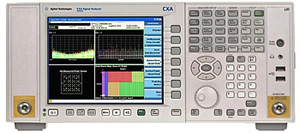Agilent Analyzers Add 8-VSB Capability

Agilent N9000A CXA signal analyzer
In the early days of ATSC VSB transmission, the only option for checking the quality of the signal was the Hewlett Packard 89441 vector signal analyzer. Tektronix soon followed with their RFA-300 analyzer, but the HP 89441 became the standard. The HP 89441—a huge, heavy, expensive and complicated piece of equipment—is seldom used today. It has been replaced by simpler and smaller devices with greater functionality, such as the new Rohde and Schwarz ETL analyzer.
In reading a description of Agilent's new “X-series” analyzers, I realized that it now has a product which could put it back in the broadcast VSB measurement business. (Agilent was created when Hewlett Packard spun off its test equipment business.) The base price of the entry level N9000A-503 CXA signal analyzer is $12,657 for a unit capable of operating up to 3.0 GHz.
These units provide basic spectrum analyzer capability and are capable of running Agilent's 89600 vector signal analysis software. The VXA measurement application with Option AYA provides modulation analysis format capabilities which include PSK, QAM, MSK, EDGE, FSK, VSB, DVBQAM and APSK. The instrument also provides a complete set of modulation quality measurements, including overall EVM, peak EVM, EVM vs. symbol time, EVM spectrum, time, spectrum, constellation diagram, vector diagram, IQ parameters, frequency and clock error and channel vs. impulse response with EQ filter.
With the appropriate options the CXA can also perform channel power measurements, AM and PM demodulation, along with noise-figure measurements. Refer to the Agilent CXA Single Analyzer N9000A data sheet [PDF]for more information.
Get the TV Tech Newsletter
The professional video industry's #1 source for news, trends and product and tech information. Sign up below.

Doug Lung is one of America's foremost authorities on broadcast RF technology. As vice president of Broadcast Technology for NBCUniversal Local, H. Douglas Lung leads NBC and Telemundo-owned stations’ RF and transmission affairs, including microwave, radars, satellite uplinks, and FCC technical filings. Beginning his career in 1976 at KSCI in Los Angeles, Lung has nearly 50 years of experience in broadcast television engineering. Beginning in 1985, he led the engineering department for what was to become the Telemundo network and station group, assisting in the design, construction and installation of the company’s broadcast and cable facilities. Other projects include work on the launch of Hawaii’s first UHF TV station, the rollout and testing of the ATSC mobile-handheld standard, and software development related to the incentive auction TV spectrum repack. A longtime columnist for TV Technology, Doug is also a regular contributor to IEEE Broadcast Technology. He is the recipient of the 2023 NAB Television Engineering Award. He also received a Tech Leadership Award from TV Tech publisher Future plc in 2021 and is a member of the IEEE Broadcast Technology Society and the Society of Broadcast Engineers.
